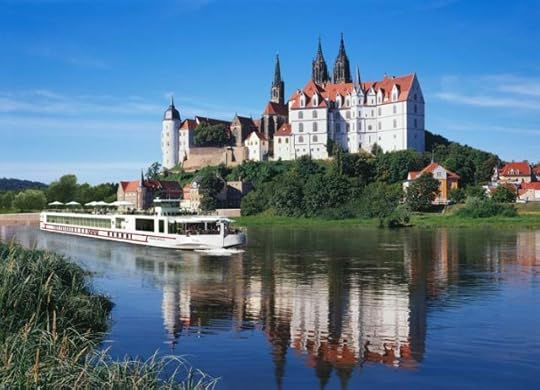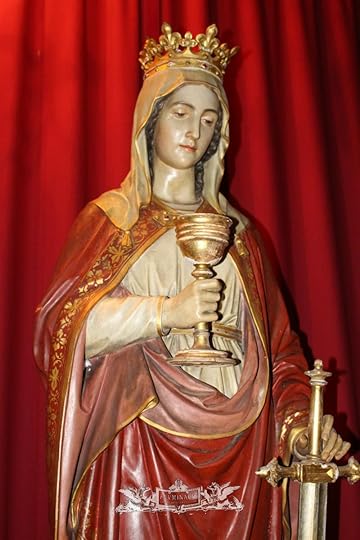Deborah Hining's Blog
September 29, 2016
Well-Behaved Women Often Make History – Guest Post by Deborah Hining
From time to time, I ask another writing mother to join my blog with a guest post. Today I welcome my friend Deborah Hining, award-winning author of A Sinner in Paradise andA Saint in Graceland, to tell her truth about an insidious lie we see almost every time we drive.
***
 Don’t believe everything you read on a bumper sticker. Deborah Hining talks about what it takes to be memorable.
Don’t believe everything you read on a bumper sticker. Deborah Hining talks about what it takes to be memorable.
Usually I take bumper stickers in the spirit they were intended, especially those that are sassy or exceptionally geeky, but occasionally one that probably is intended to be funny will rub me the wrong way. The one that is currently on my “It disturbs me to see” list reads, “Well-Behaved Women Rarely Make History.”
I find it irksome because, for one, it is not true.
Think hard. How many badly behaved women can you think of who have…
View original post 1,088 more words


September 7, 2016
Part 3 of our Viking River Cruise: The Blue Danube, Austria, and Hungary
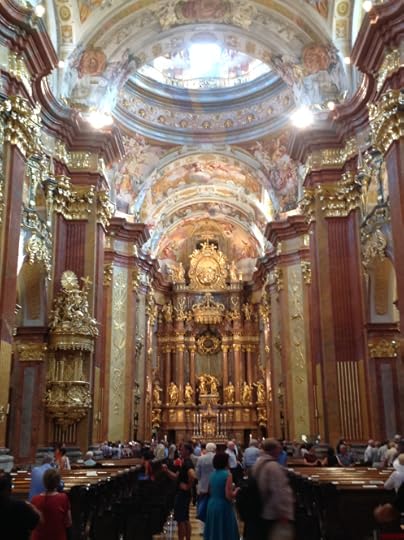 Just to set things straight, the Danube is not really blue: it’s just your typical brown river, albeit through some of the world’s most gorgeous landscapes, towns and cities. It came to be called “Blue” because when Napoleon attacked with his blue-uniformed army, the Austrians handily defeated them, forcing them en masse into the river. On that fateful day, the water looked blue because of all the floating dead soldiers. Every town we visited in Austria made the claim to be the town that whooped Napoleon, but they all agreed that’s how the name came about.
Just to set things straight, the Danube is not really blue: it’s just your typical brown river, albeit through some of the world’s most gorgeous landscapes, towns and cities. It came to be called “Blue” because when Napoleon attacked with his blue-uniformed army, the Austrians handily defeated them, forcing them en masse into the river. On that fateful day, the water looked blue because of all the floating dead soldiers. Every town we visited in Austria made the claim to be the town that whooped Napoleon, but they all agreed that’s how the name came about.
Both Austria and Hungary have interesting histories that are intertwined, having enjoyed the reign of the extraordinarily wealthy and powerful Hapsburg family, who not only ruled the Holy Roman Empire between 1438 and 1740, but also ruled Spain and most of central Europe up through the 19th century. The Hapsburgs were unique among the royals of Europe because they figured out that the best way for the dynasty to increase their holdings and power was not by waging war, but by systematically marrying their children into other royal households. Their motto was, “Leave the waging of wars to others! But you, happy Austria, marry; for the realms which Mars awards to others, Venus transfers to you.”
They were so successful in inserting themselves into the ruling elite of all of Europe that the Hapsburg Empress Maria Theresa became known as the “Great-Grandmother of Europe.” There was an eventual drawback to this marrying and breeding strategy, however, for by the late 19th century, Hapsburg blood ran through the veins of so many of Europe’s rulers that there was nobody but their own left to marry. “The best spouse for a Hapsburg is another Hapsburg.” became the new family motto, and excessive inbreeding resulted in the eventual extinction of the family.
By the early 20th century, Austria had shrunk from being a major European power to the tiny nation it is today. But thanks to the reign of the Hapsburgs, their money, power, and their artistic sensibilities, Austria’s cities remain among of the most glorious of Europe. Our first stop, Melk, boasts Melk Abbey, which is even more beautiful than the Bishop’s Palace of Wurzburg. It has a library I could live in forever.
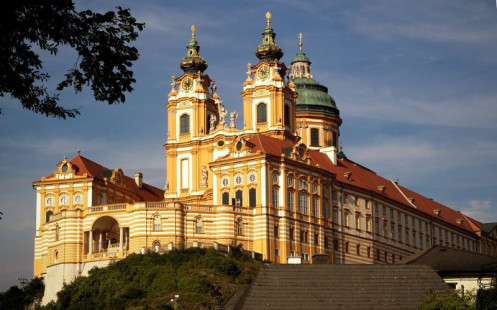
Melk Abbey
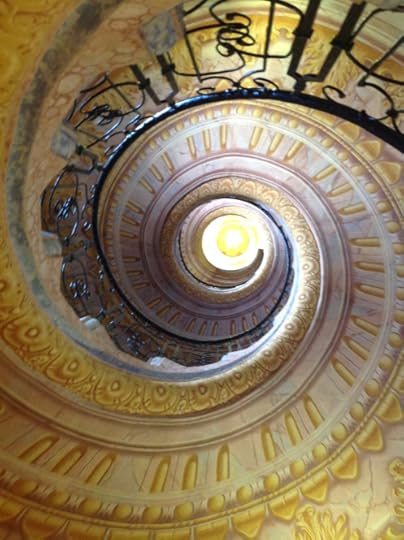
Melk Abbey interior stairwell
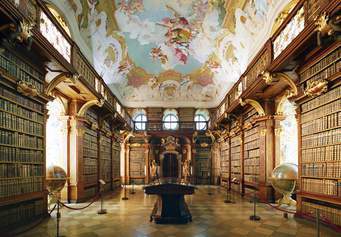
My future home, the Library at Melk Abbey
From Melk, we sailed on to Vienna, home of Strauss and Mozart, mouth-watering chocolate, and architecture that was designed to be jaw dropping. Forget the expression, “less is more.” In Vienna, MORE is more! Driving around the Ringstrasse, the wide boulevard encircling the inner City, is like driving around in a wedding cake competition. Each building is a work of art, and graceful statues cavort on every corner.
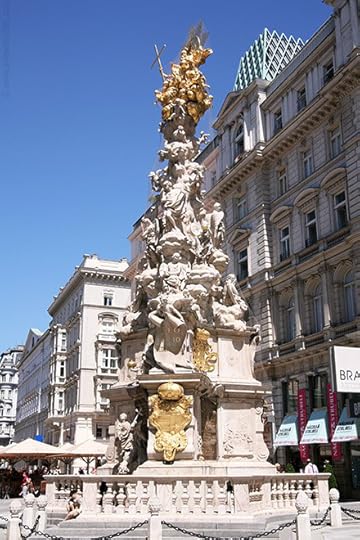
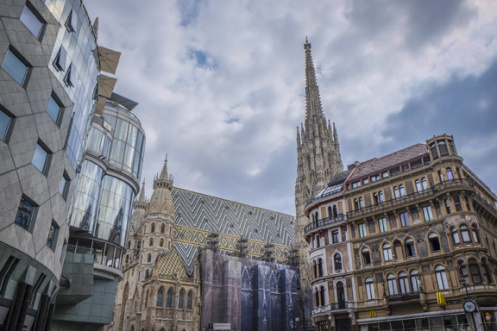
The main market is a wonder. It looked and smelled so good, all I wanted to do was walk up and down the place, sniffing, gazing and smiling.
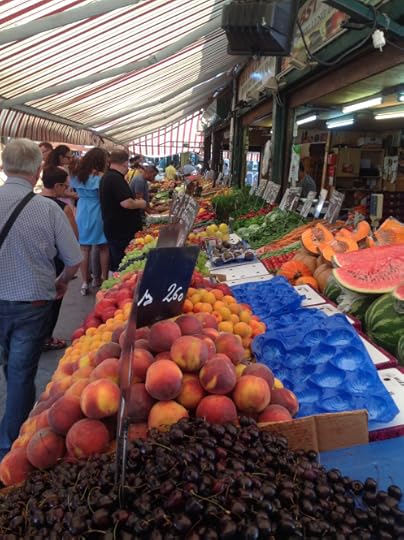
After Vienna, continuing along the Danube, we crossed over into Hungary, and immediately we noticed a difference, not so much in the architecture, but in the people. In Austria, everyone is blonde, blue-eyed, and large. In Hungary, they are all small, brunette, and brown-eyed. Amazing, especially since Hungary and Austria were once all a part of the same empire, and one would think, all a part of the same extended family. However, the small, dark strains of the original Celts are still dominant.
Vienna intended itself to be a lavish confection, but it seems that Budapest decided to pile it on even more. I believe that surely Walt Disney used Budapest as the inspiration for his theme parks. The place is a wonderland of whimsy. We had been to Budapest about 15 years ago, and at that time, it was barely out from under Soviet rule. Then, the people had a hard edge to them, nobody smiled, and the city seemed unkempt and noisy. We enjoyed it, but we did not fully appreciate its splendor. Now, it feels as if it is breathing again, the people are happy, the city is clean and vibrant.
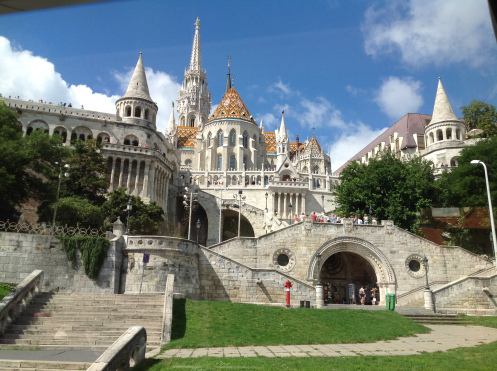
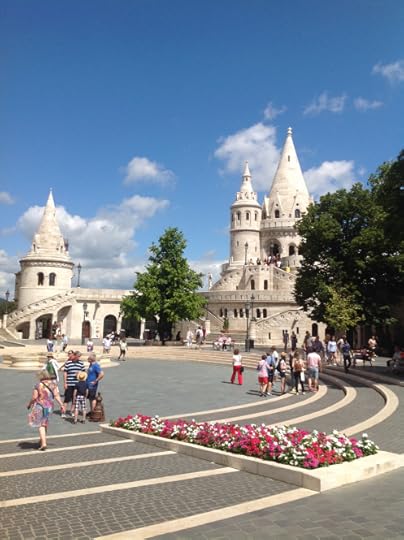
The people seem almost giddy, and for good reason. It has been an independent, free county only for about 25 years, for throughout its history, it has always been under the thumb of another occupying power. Because Hungary is smack in the middle of Europe, everybody wanted it for their own, and everybody invaded it. It was founded by the Celts, but it did not stay in their hands for long. Rome took it over in the first century; they were followed by the Huns, the Bulgarians, the French and Germans, the Mongols, and the Turks. Finally, in the 18th century, the Hapsburgs grabbed it, controlling it from Vienna. Under their rule, Budapest became one of the most beautiful and important cultural city in Europe, even through the various occupations after the First World War
Germany took Hungary again during their invasion of Europe, then decimated the cities as they fled the advancing Soviet Army at the end of World War II. By the time the Soviets laid claim to it in 1945, it was devastated, poor, hungry, and demoralized. Hungarians never stopped hoping for their independence, however, and kept a steady spirit of hope and resistance until at last the Soviet Union collapsed in 1989. Now, finally, they are free and independent, and very, very happy about it. As I mentioned earlier in this post, they are gradually beginning to understand the joys of freedom, and as they do, they look back, remember, and honor their slain.
Prior to WWII, Hungary was a safe haven for Jews, but the Nazis decimated the Jewish population during the years between 1939 and 1945. One of the most moving and meaningful places I saw was the memorial of the shoes. One night in December, 1944, the Nazi army captured several Jews and anyone they could find who had sheltered. They marched them to the banks of the Danube, forced them to take off their shoes, and then they shot them. The bodies fell into the river, but their shoes remained for some days afterward. The memorial, made of iron reproductions of the shoes left along the riverbank, is a solemn reminder of only one of many tragic incidents in Hungary’s history.
 The shoe memorial.
The shoe memorial.
Now, the city is beautiful and happy. Our strolls around during the day were breathtaking, but in the evening, our last night on the boat, we were treated to nighttime views as we sailed up and down the Danube, under the magnificent bridges. Oh my! As we stood up on the sundeck in the cool night, every bridge and building was lit up. Statues leaped out from the shadows. Hillsides bloomed with beautiful hidden alcoves, and the water shimmered with sparkling lights. Pomp combined with whimsy was everywhere! It was a night to remember—bittersweet, as we gazed in wonder and said our goodbyes to the friends we had made along the way.
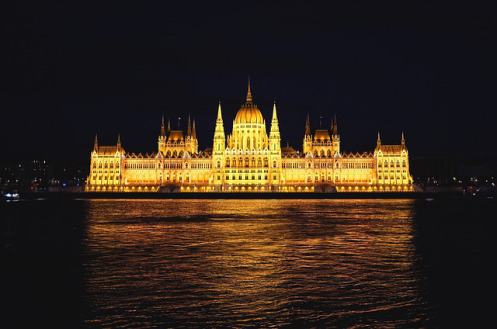
Budapest Parliament
We were sad to part company with our fellow passangers, but Budapest was our last stop, and the end of the day meant the end of our trip. The ship left the next morning to continue its journey to the Black Sea. Some of our lucky shipmates were continuing on, but we sadly had to say goodbye to one of the best vacations we have ever had. You can bet that if we are ever in a position to do this again, we will jump on it. I hope someday to sail thriough Russia and the Scandanavian countries. Fingers are crossed!
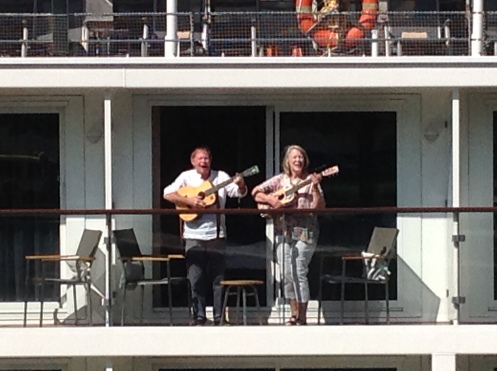
A farewell serenade from our friends who were lucky enough to continue to the Black Sea


August 31, 2016
Our Masterpiece Theatre River Cruise Part 2: Germany The Rhine, Main, and Danube Rivers, and the Main-Danube Canal.
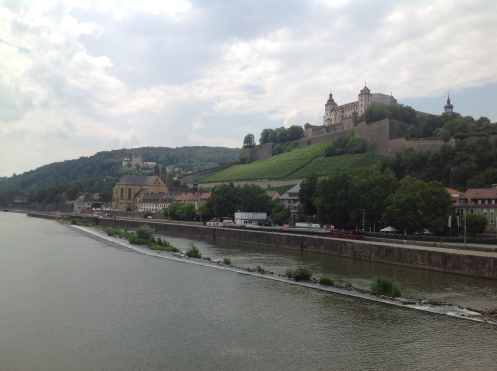
I had been looking forward to this part of the journey because I am thinking of setting a future novel in WWII Germany. It was all I had hoped it would be. Not only did I get a marvelous history lesson that I would have not have gotten if I had not come here, but it was also a feast for the senses. The stretch of Germany we saw along the Rhine, Main, and Danube Rivers is breathtaking, the towns are straight out of fairy tales, and the people are beautiful and kind.
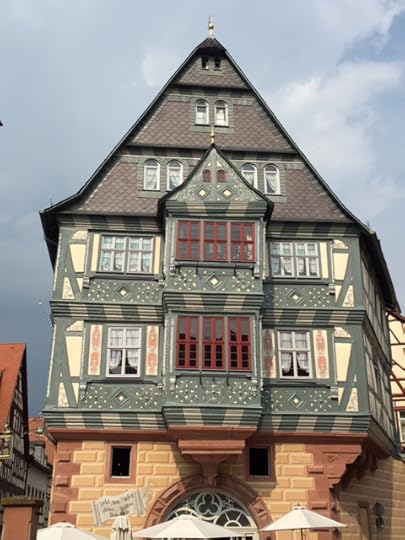
One of many half-timbered wonders
Cologne was our first German town, home of the world’s first eau de Cologne, Roman ruins that have been beautifully preserved and restored, Northern Europe’s largest cathedral (a Gothic wonder that was mercifully spared by Allied bombers), plenty of brauhauses, and best of all, a chocolate museum (a living museum, of course, with plenty of samples!).
After that, we were treated to Koblenz, a veritable fairy tale, and nearby, in Marksburg there is a well-preserved castle high on a hill, complete with a torture chamber and an array of well-dressed knights representing the styles of that brotherhood from the 11th century through the age of chivalry. It also has a view to die for.
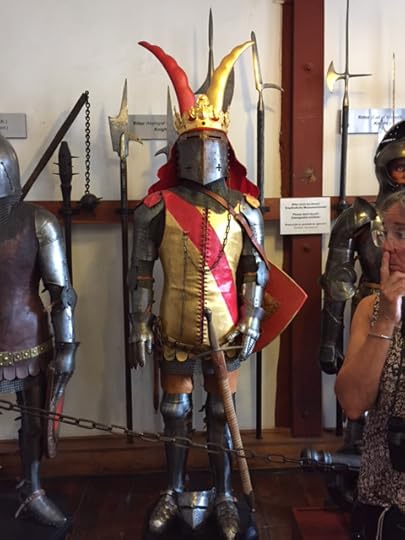
One of my favorite knights in shining armor
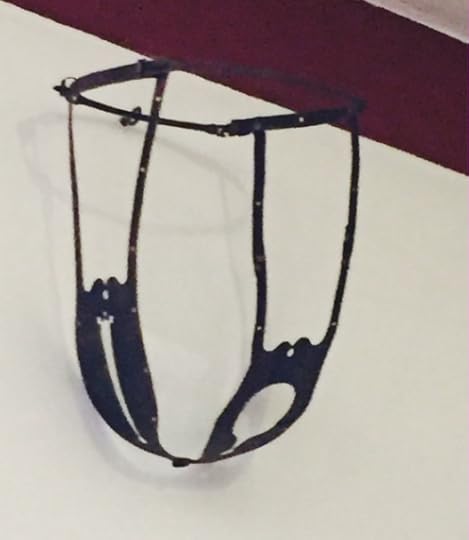
This was not one of the torture devices, although it should have been. It is a medieval chastity belt. Yep. They really existed!
We had lunch in the market square, where they show us what a European farmer’s market is like. The 12 varieties of mushrooms alone made me stand and drool for several minutes, and within 10 minutes, my hands were pleasantly sticky with the juice of gorgeous cherries.
After that I walked up a very big hill to the Ehrenbreitstein Fortress with some newfound friends for another fantastic view of the day. When we were walking back down, we came across a group of young people from Madrid, singing and dancing with Spanish flags in front of a church. When I stopped to admire them, they drew me into the dance and showered me with happiness. One of the boys, who must have been about 14 or 15 spoke to me in very broken English that I could not really decipher, and gave me a gift–a leather bracelet with a dangling cross that looked like a rosary, except instead of beads, there were knots tied along the length. You are, according to them, as they ticked off the knots, to say, “Ave Maria, Ave Maria, Ave Maria, pray for the war.” I had no idea which war they were referring to, but they were so precious and so eager to share with me, I was beguiled by them. The boy who had given me the bracelet looked at me like he missed his mama, and I so wanted to gather him in my arms and cuddle for a minute, but I was afraid that might seem weird, so I held back.
Now I am sorry, I did. All of these babies and their desire to connect made me realize that this is why we travel. They were away from home, probably for the first time, on their way to see the Pope in Budapest, and they were a shining example of tomorrow’s hope. My arms still ache for the memory of the hugs I did not hand out.
By now, we passengers were getting to know each other pretty well. Meals and afternoon happy hours were spent in easy conversation as we floated along past castles, cathedrals, and vineyards, while sipping the excellent local wines. Most of the people on the trip were, like us, experiencing their first river cruise, and considered it the trip of a lifetime. Most were Americans and Canadians, but we also met some darlings from Australia, Barbados, and Norway. One Australian friend was a musician, and in the evenings, he and the ship musician treated us to impromptu, rousing rock and roll concerts. Of course, we all joined in the chorus. As good as the trip was, the experience was made better by these delightful people. All of the crew were from exotic countries, and they vied among themselves to give every passenger the best experience imaginable. The young woman who cleaned the cabins on our deck played practical jokes on me and laughed at me when I fell for them. I miss her.
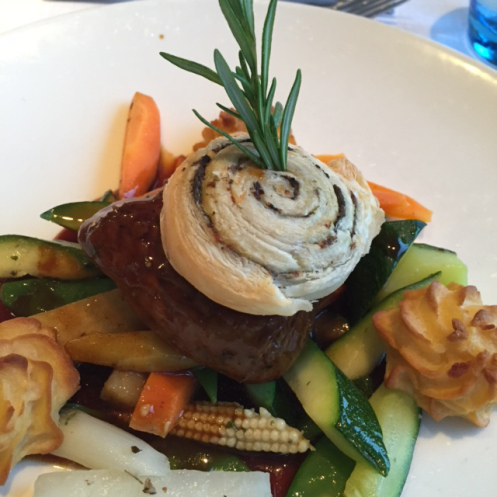
Just your typical supper on the boat
Sailing through the Rhine Valley, chock full of castles and more fairy tale scenery, we stopped at the charming medieval town of Miltenburg, full of crooked, cobblestone lanes and half-timbered houses, most of them sagging in the middle or leaning at interesting angles. That was followed by Wurzburg, famed for its Baroque masterpiece, the Bishop’s Residence palace, which is about the biggest box of eye candy I have ever seen. Although it was beyond splendid, it seemed comfortable and inviting, unlike many of the vast cathedrals and palaces I have seen in Europe. It has a library to you could live in forever

Interior view of the stairwell, Bishops Palace
Next came Bamberg, another medieval charmer, which features an old town hall built on a tiny island in the middle of the Regnitz River. In the cathedral, there is a mysterious statue of a man on horseback. He’s very old, perhaps from the early 13th century, and time has worn off all his paint. Nobody knows who it is, but the Nazis thought he was so magnificent they used him as an emblem of Nazism, floating his image on banners all over Germany. They painted him blonde and blue-eyed because, of course, he had to be representative of the great Aryan race. The beautiful irony here is that recently, new technology has been able to deduce the color of pigment that had been on the stature originally. He was swarthy.
Because of my interest in Hitler’s regime, I was anxious to get to Nuremburg to see the where the infamous Nazi rallies took place and the site of the war crimes trials at the Palace of Justice. It was fascinating, not just because of its historical significance, but also because of the role the place has played and is still playing in the lives of Germans. You have seen pictures of the Zeppelin Field where Hitler (and Charlie Chaplin doing his famous imitation) held forth. In these pictures, it looks spiffy, with roaring crowds, manicured grounds and soaring monuments. Today, it is a sad, derelict place, ignored and shamed. As soon as the war ended and war crimes came to light, the German people were deeply disturbed at what had happened right under their noses, and wanting to distance themselves from the events of the 30s and 40s, they just walked away, locked up their memories and their parade grounds, and tried their best to rebuild their lives. They were so closed to the idea of reliving the history of the war that they would not even speak to their children about it. The Nazi Regime was not written about in the history books. A whole generation of children grew up, unable to even ask questions about what happened in the years between 1930 and 1945.
I understand why this happened. Although many Germans did not know what was happening to the Jews, communists, homosexuals, and outspoken opponents of Nazi crimes, they surely had more than an inkling that the regime was not as glorious as it pretended to be. Most were terrified of what might happen to them if they did not bow to the rules of the times, and even though they were aware that their friends were disappearing, most of them hoped that officials were beingn truthful when they told them those friends were just being relocated to safer, or more industrial areas where they could find jobs. As Albert Speers confessed in his book, Inside the Third Reich, he didn’t want to know what was happening, so he made every effort not to know. He ignored the signs. He turned his eyes when he was confronted by a horrible truth. He “knew” even though that “knowledge” was not confirmed until he saw the evidence in the Nuremburg trials.
What would you do if you were living through a repressive regime, with the fear that government agents might come banging on your door in the middle of the night if you aided and abetted “terrorists?” In the airport, I see signs posted, “If you see something suspicious, report it!” We do what we think is patriotic and right if we see someone who looks like a bad guy. How do we know who is bad? The media tells us. We rely on honest reporting to tell us whom we should and should not trust. In Nazi Germany, the only information broadcast was written by Nazis strictly to advance the Nazi cause. It was fed to the people in carefully controlled ways that did not allow them to form opinions on their own. I can see why the people buried their heads, and I can understand why they were so horrified when the truth came out. The mayor of a town near one of the Jewish death camps and his wife went to tour the camps shortly after the liberation, and afterwards, they came home and hanged themselves. It is understandable that the whole nation did not want their children to be exposed to their shame.
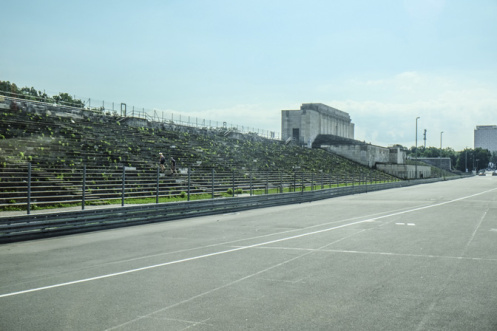
Hitler’s beloved Zeppelin Field, now with weeds growing in the stands. The huge Eagles are gone, the concrete is cracked.
Now, things are changing. The Germans are requiring that all schoolchildren visit sites connected with the war, that they understand why it is so important to keep their democracy robust and vital. I wish we Americans were so in love with liberty that we required our own schoolchildren to understand how precious it is, how important truth, freedom of the press, freedom of religion, freedom of the mind are.
Leaving Nuremburg sobered and a bit frightened, we came on to Regensburg, where we were plunged back into the beauty of Medieval Europe. The oldest city along the Danube, Regensburg boasts a gorgeous old Stone Bridge, constructed in the 12th century, and now a place to buy a glass of their famous Riesling wine to sip above the beautiful old arches. Regensburg also is the major site of Nazi book burnings. It’s hard to imagine pogroms and book burnings in this sleepy, friendly little village.
One of the surprising things about Germany was the number of locks we had to go through. I think there was something like 69 of them. Fortunately, we went through most of them at night, and sometimes we were dropped off at one location where we spent the morning, then drove on to meet the ship at another town, which had gone through a few locks without us. Since the ship traveled at only about 8 miles per hour, we were able to zip around to a lot of different places on comfortable buses, then return to the ship a few miles upriver in time for lunch or dinner.
Finally, we came to Passau, where we got to spend a little extra time because the ship needed some unexpected repairs, and would that all of my days dedicated to vehicle repairs were like this! We were treated to the most fabulous organ concert in a church with no few than 7 sets of organ pipes, all played at once. You could feel the music in your bones, literally. I can see why Medieval Europeans thought that the cathedrals were the closest thing they could see of heaven. Between the music, the soaring architecture, and the art, there were moments when I thought I was there. What a magnificent end to our cruise through Germany! I now am officially in love with this beautiful country.
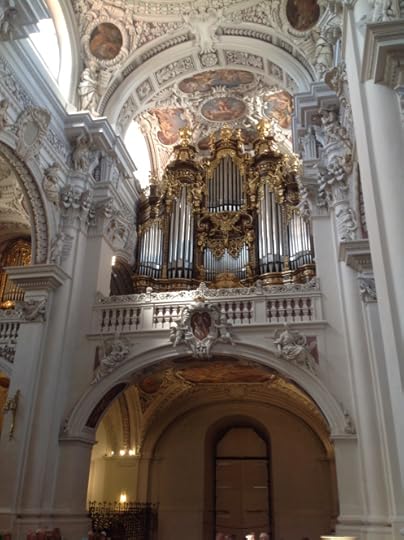
The music from these babies will rattle your bones and send your spirit soaring
In my next blog post, we will move on to Austria and jump into the history of the Hapsburgs, the most influential family of Europe’s history. They were rock stars, so stay tuned for Part 3 and beautiful Bavarian Austria.


August 17, 2016
Rolling Up and Down the River, Masterpiece Theatre Style
After years of lusting after one of those Viking cruises I see in the commercials on PBS, I finally scored one at a price we almost could afford. I think they realized we were never going to take them up on their occasional “specials,” so they just quit fooling around and made us a last minute offer we couldn’t refuse. Before we could think much about it, Mike and I, along with our best buddies, found ourselves slinging clothes into suitcases, preparing to cruise through The Netherlands, Germany, Austria, and Hungary on one of those sleek, beautiful vessels you see during the breaks of Masterpiece Theatre, drifting through dramatic valleys lined with castles and cathedrals. A dream comes true!
Sailing on a Viking ship is a whole different, more wonderful experience than what we are used to, being as how all our past trips to Europe have been of the budget variety. Yes, it’s everything it’s cracked up to be, and more. PBS doesn’t lie! Although our cabin, being the cheapest accommodations available, was in the bowels of the ship (one passenger called us “bilge swillers”), we did not mind that it was small and practically below the waterline. We only needed to sleep there. The rest on the time on board, we were free to hang out in the cozy lounge or the sun decks and pretend to be members of the idle rich. The meals were sumptuous and delicious, the wine flowed, we were treated like royalty, we met a lot of really nice and interesting people, and we learned a lot. Pretty much a perfect vacation.
This the first of several installments that will give you the lowdown on what it is like to make the grand tour through central Europe on a riverboat cruise.
Part One: The Netherlands.
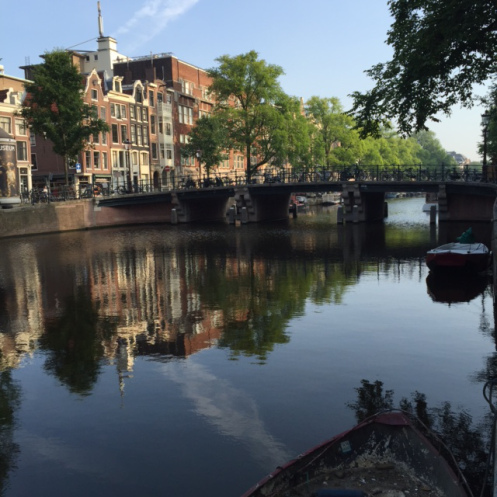
We spent only 2 1/2 days here, but there was much to see and do, and I learned more interesting things here than I did anywhere else. Amsterdam was far more beautiful than I thought it would be. The light, even in midsummer, has that magical quality captured so beautifully by the old masters, and everywhere we looked, we saw water, light, and space. After the narrow medieval streets of most of Europe, it was surprising to see how much room Amsterdam has for wide streets, tram tracks, bicycle lanes, canals, and foot traffic. Later, I discovered that the streets are extra wide because there used to be more canals, and wider ones. Many have been filled in now, leaving lots of luxurious space
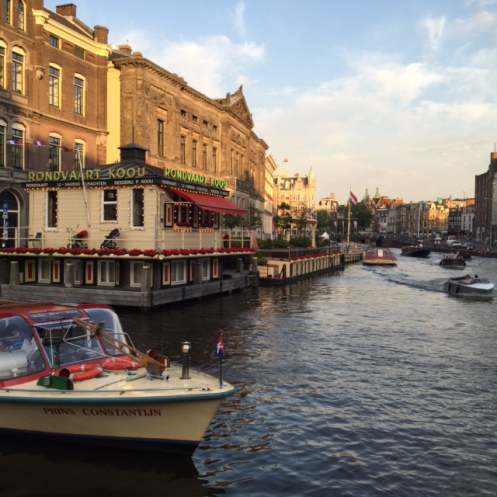
The Van Gogh museum is full of wonderful art, and it also featured exhibits regarding the artist’s life: his gentle personality, his madness and death. Interested in the ear incident? Here’s what I learned: He really did chop off his whole ear. Not just a little bit of it, but somehow hacked off the whole thing off right up against his head, leaving only the little piece at the bottom with the earlobe attached.
This event marked the beginning of his madness—not just depression and acting a little weird, but stark raving lunacy, which lasted off and on for about a year and a half before his death. There were periods of lucidity, but the poor man was tortured for most of that time, finding a little peace here and there only when he was painting. While his doctor at the time was able to bring him some relief, the specific name for his illness has never been determined conclusively.
You might be interested to know that there is also a debate about whether Van Gogh really killed himself. There is some evidence to suggest that he was accidentally shot by some boys who were nearby fooling around with a pistol. He told his brother he did it himself, but he may have said that to keep the boys from getting into trouble. That version is very compelling to me because it is in keeping with the personality of the kind and compassionate man we got to know that afternoon in the museum.
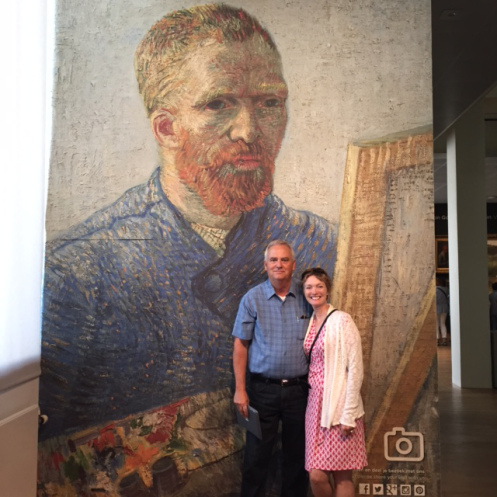
Me and two of my main men, Mike and Vincent
I am researching the underground resistance movement of WWII, so was keen to visit the Dutch Resistance Museum. Even though they had almost no help from the Allies, since the Nazis had pretty much had buttoned everything up by 1940, The Dutch ran a very robust Resistance movement. Not only did these brave citizens aggressively fight the Germans by killing Nazis and blowing up bridges and factories, they also used other, less dramatic tactics to thwart the invaders. They forged documents for Jews, trapped Allies, and Resistance fighters, and burned down registry offices so that the Germans could not check the legitimacy of these forged papers. They developed underground railroads to smuggle Jews and downed Allied pilots to safety. They made sure plenty of “accidents” happened at the factories where they worked and managed to slow production by strikes or by producing armaments and explosives that were faulty and worthless. One woman who was arrested for being a constant monkey wrench in the works was put in jail and told to darn the officer’s socks. She still did her part. Pretending to be simple minded, she sewed them all shut.
They paid for their resistance with terrible retributions. They were starved, murdered, and put into brutal camps. During our trip, I met some people who had been children in the country at that time. They still remember how hungry they were and what a celebration they had when the Allied planes came flying overheard in 1945, dropping food supplies, which saved them from certain starvation.
I came away humbled, grateful, and terrified. We Americans are blessed, but the luxury of the precious democracy we enjoy is fragile and so vulnerable that it would be shockingly easy to lose it if we aren’t vigilant, if we don’t take our responsibilities of self-government seriously. When Hitler first started campaigning, nobody took this ranting nutcase seriously, even when he started amassing a large following. When he was elected Chancellor (equivalent to our President) in an official, national election, people were shocked that he actually had convinced enough people to vote him into office. But they felt they did not need to worry. Germany was a democratic republic, full of checks and balances, and besides, they reasoned, there were enough other decent people in government who could hold him in check. They were wrong. It took Hitler under three months to destroy the democracy and establish himself as Dictator.
I also met a man whose grandfather had been a member of the Resistance. He had worked for Coca Cola, driving a delivery truck. The Germans, being fans of Coke themselves, did not think to check for guns and ammunition to supply Resistance fighters hidden underneath the cases of Cokes.
I’d like to buy the world a Coke right now.
Of course, we visited the Red light district, which was surprisingly civilized, more genteel than The French Quarter on a Saturday night. Yes, there were lots of bars, crowds, and “coffee shops” on every corner where you can buy pot either in tidy cigarette form, or in cookies or brownies. There also are nearly naked girls standing or dancing behind big, bright, storefront windows hawking their wares. But oddly, the scene seemed less sleazy than Bourbon Street where the fully dressed hookers hide behind curtains. There were no aggressive hawkers or tough bouncers in the bars, no blaring music or that frantic atmosphere you see when people are out to see how much trouble they can find. No one was drunk, rowdy, or itching for a fight; everyone was chill and smiling, just strolling around enjoying the atmosphere. The prostitutes, all confined to their bright display cases, were just young women, not exactly looking like fresh-faced UNC freshmen rushees, but not depraved looking, either. They looked like your typical secretary or computer programmer, not miserable, not overly happy, maybe a little bored, just girls doing their job. Nobody seemed interested in them except a couple of ladies working for the Salvation Army who made their rounds to each of the girls, handing out tea, coffee and the occasional sandwich. They were greeted like old friends, with hugs and laughter.
I talked to the Salvation Army ladies, who told me that the girls do not consider prostitution a degrading profession. They are protected, closely monitored by the government, and are given free education and medical services. If they want to get out of the sex trade, they can, and the Salvation Army ladies and the government help them retool themselves for a different career. It was a far cry from the image that comes to mind when we think of prostitutes in the US, and it makes me rethink the way we do things in America.
We sailed during the night and woke up to a cheerful drizzle at the quintessential Netherland village of Kinderdjik, with 19 functioning 18th century windmills and canals that date back to the 13th century. The workings of the dykes and canals, and windmills to keep the water pumping away from the land is amazing. I found it interesting that the Dutch wrested 60% of their land from below the sea by engineering genius during the same time my own ancestors thought the best way to get their hands on a bigger chunk of land was to go hack their kinsmen and neighbors to bits, then move in.
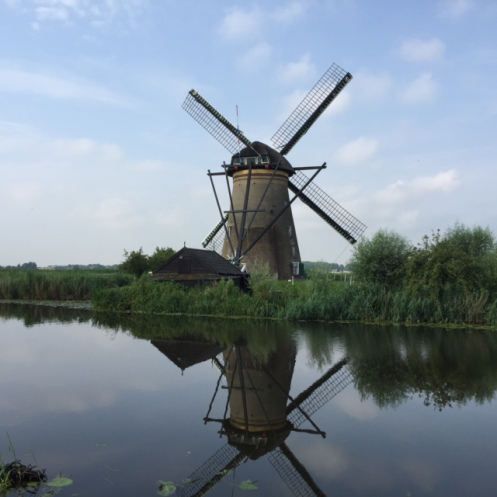
We got to go into one of the working windmills and to talk to the miller. Although we think that a “miller” is someone who grinds corn or flour, to the Dutch, he is someone who takes care of the windmills. Back in the day, the miller lived in these 5 story buildings with a tiny footprint with his whole family, usually of a dozen children or so. He was not allowed to leave the mill at any time. No vacations. 365 days a year spent right there on the spot so that he could quickly change the angle of the sails anytime the wind shifted. But it was and is considered a very prestigious occupation.
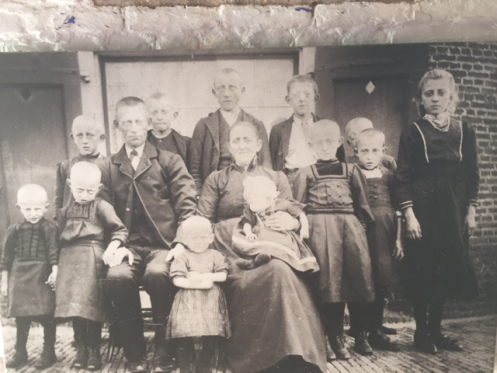
A miller and his family who all lived together in a windmill back in the day. Note the bald heads of the children except the oldest girl. She was of marrying age, and thus needed to be pretty to enhance her prospects. The others no doubt are fighting lice.
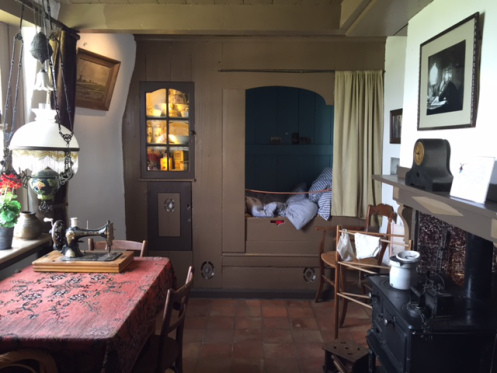
Here are some interesting bits of fact I picked up in Kinderdijk:
The country is called The Netherlands, not Holland. North Holland and South Holland are merely provinces. There are actually 12 provinces, but since North and South Holland border the sea, most of the sailors who came from the region came from one of the Hollands. When people asked, “Where do you come from?” the answer was always “Holland.” That gave the impression that the whole country was named such.
How Americans (especially those from the New England region) came to be called “Yankees:”Two common Dutch boys’ are Jan and Kees. The Dutch pronounce them “Yan” (short a) and “Case,” but the English pronounced them “Yan,” with a long a, and “Keys.” Thus “Yankees.
After our windmill tour, we ate lunch on the ship and set sail, watching the gorgeous landscapes along the Rhine River from the sun deck. The weather was beautiful, the wine was plentiful. I got used to it in a hurry. Dinner was a glorious affair, and we began to meet gracious and interesting people who would soon become friends. No idle rich here! Everyone seemed just like us–excited and happy to be here, interested in everything and everybody they met.
We spent the night still drifting upriver until we passed into Germany, docking the next morning in Cologne, the home of Roman ruins, a spectacular cathedral, plenty of brauhauses, and first eau de Cologne ever made. The Netherlands was a success, and we looked forward to the rest of it! Stay tuned for Germany.


July 5, 2016
Deadheading on the Fourth of July
There is a kind of pleasure in gardening on a hot, steamy day after a week of rain, not because the body is comfortable, but because once you get past the sauna-like atmosphere as you wade into a sea of daylilies to weed and deadhead, you find a kind of glory in playing God. In your primeval, swampy, steamy garden, you begin to believe you have complete control to change the world. Reaching down into the earth, you experience the rare pleasure of feeling the tenacious roots of weeds yielding easily. The clinging, red, North Carolina clay even gives up Bermuda grass roots after several days of soaking rains—a miracle if ever I saw one.
Gardening time means thinking time. It is best not to contemplate the slushy mud at your feet or the mosquitoes feasting on your flesh, but on the world you are creating and re-creating. Chopping off a spent daylily bloom suddenly brightens the garden, pulling out a clump of crabgrass reveals a lovely chocolaty backdrop for your Shasta Daisies to shine. You see the asters begin to breathe as you clear away the suffocating pigweed. Yes, that must be what God feels like when He looks down and sees what He has set in motion.
There is a difference between us and God. When we plant a garden, we do not set things to spinning and then step back to observe how free will might play out. No, we keep our hands right down in that mud, moving our creation around, changing, pruning, thinning, deadheading. We can’t leave well enough alone and let our garden get itself into a right proper mess, with plants stepping out of their boundaries, taking over more vulnerable beauties, crowding, littering, running rampant, out of control. We determinedly pull and pluck, dig and plant, convinced that we eventually will eradicate all the weeds, we will keep the verbena to a respectable height and the black-eyed Susans vertical. Once we get the right combination of nutrition, nothing will flop over, sprawling into the pathways. Disease and pests will find an impermeable barrier at the edge of our yards. Bunnies are allowed, but they can’t eat the phlox. Or the hosta. We strive for perfection, even when we prefer our perfection to look untamed. I like a riot of colors, a variety of heights and breadths, a garden that looks wild and exuberant, but is weed-free, disease-free, flop free, and not too rambunctious. In other words, I tell it: be wild and full of abandon, but mind your manners. Constrain your enthusiasm. Don’t elbow your neighbors. You know, that kind of wild and full of abandon. Messy, but pretty, like Julia Robert’s hair the morning after.
As I clip, pull, and sweat, I find myself wishing that God would come garden in us more. It seems He has wantonly scattered Life without even looking to see where things landed. He sends the rain and the sunshine at sometimes-odd intervals, enough to generally sustain the Life He began, but even those are capricious, sometimes as destructive as they are nourishing. It’s as if He just threw everything, the robust and the delicate, the beautiful and the vile, the mannerly and the boorish onto the empty field, then stood back, keeping His hands off to let us run amuck as we choose. I am reminded of the parable about the seeds falling on good ground, on hard ground, and amid the weeds. Only the seeds that fall on good, clean, fertile ground take root and bear fruit. The unlucky ones are doomed to wither without ever fulfilling their destiny. Why? Is this a form of predestination? Or is it a parable of how our reckless exercise of free will lands us in a barren and desolate place?
I can’t answer those theological questions. I can only ask them as I ponder whether or not to dig out the excess daylilies now or wait until the fall, or if I should go ahead and chop down those stalks that still have one unopened bud on them, knowing that tomorrow it will be completely spent and I will have to brave the mosquitoes and spiders to wade back into the mass to do it then. (Always, I decide to let the last bloom have its day. It kills me to waste a single day of daylily glory. Roses, too. I can’t bring myself to lop off a huge mass of spent blooms if there is a single unopened bud left in the middle.)
So, in the cauldron of summer, when it is hot, muggy, mosquito infested, and squishy underfoot, I weed and deadhead and ponder the mysteries of life and eternity, and become the kind of god I wish Our God would be sometimes—controlling His Creation, making it nicer, cleaner, tidier, but with the illusion that we are completely free to live as we choose. I impose my will on my subjects, for a little while, at least, telling myself that it is getting closer to perfection because of my hard work. And then I step away for a moment. When I look again, I see that, in fact, I have not succeeded at all. Nature is nothing, if not Free Will. I suppose that God, in His wisdom, has set Free Will as one of the laws of the universe. It also seems that we humans want free will all to ourselves. I want to do what I want to do, but I also want others to do what I want them to do. The madness of it is, I actually believe that eventually, I will be able to impose my will on my creation, and my little Eden will bow to it.
I would write more, but I see that the beautyberry bush has grown so big that it is crowding out the rose beside it. That’s just as well. The rose would look better if I move it between the birdbath and the purple irises. Time to go play god again.


May 18, 2016
‘Why the Words Come’ with Deborah Hining
Friend and fellow writer Elizabeth Hein is hosting me on her blog this week. Chec is both out
 Elizabeth Hein - Scribbling In The Storage Room
Elizabeth Hein - Scribbling In The Storage Room
Today it is my pleasure to host Deborah Hining in the Storage Room. Deborah and I met several years ago through our editor, and I am continually impressed by Deborah’s talent as an author and her generosity as a human being. The thing I like best about her novels is the way she seamlessly incorporates faith into the story and leaves the reader feeling enriched by the experience. Without further ado, here is Deborah Hining with some thoughts about why the words come…..
People sometimes tell me that they would like to be a writer, but they can’t get it together enough to sit down and write: they have ideas but lack the discipline to put them down. Or they know what they want to say, but they can’t find the words to say it. I know exactly what they mean. I, too, lack discipline. I have few ideas and my thoughts…
View original post 1,398 more words


March 8, 2016
Cuba, Final Days

Day 8, February 13, 2016
My stomach prevented me from enjoying the day to the fullest. No breakfast, white rice for lunch, while everyone else was enjoying a spectacular meal in an open-air restaurant. I was glad to crawl on the bus and sleep for a long road trip to the southern coast. Our destination was Cienfuegos, where we would stay for the next 2 days. On the way, we stopped at the museum commemorating the Bay of Pigs invasion, a collection of rather sad looking artifacts of war and many enlarged photographs of the battle that took place.
Cubans have not learned the art of subtlety. Every display contains phrases along the lines of: “Cowardly American Imperialists and their Traitorous Puppets,” and “Brave Patriots who stood victorious against the aggressors.” You get the picture.

The Bay of Pigs Museum. Not much here except some pictures, posters, and Revolution slogans
Cienfuegos is a fairly new, beautiful town situated on a beautiful bay. Settled by the French in the 1890s, it is called “The Pearl of Cuba” for good reason. The thing that impressed me most about this town, aside from the long boardwalk along the bay where everybody congregates, is the incredible midcentury modern architecture of most of the houses there.

House that looks like a boat. Notice how the people use their roofs
When I think of midcentury modern residences, I tend to think of cheap derivatives of Frank Lloyd Wright’s style, the kind of low slung tract houses that sprang up all over the United States after World War II. Those homes have never appealed to me, but the houses all over Cienfuegos are simply beautiful, whimsical, clean, and decorative.
There also is a good deal of beautiful French Colonial style architecture here. Obviously, this town has been inhabited by some very wealthy people. They did not mess around with cheap design.

love the colors

Downtown Cienfuegos
I was curious about the fact that there are so many single family homes in Cienfuegos. People own their houses here, but ownership can be precarious. After the Revolution, Castro nationalized all property owned by foreigners, supporters of Batista, and anyone just too wealthy for the good of the cause. This might have been a problem for his brother, Raul, who happened to own a great deal of property. According to local legend, Raul balked at the plan to dispossess the wealthy (which would include him), until Fidel reminded him that, being the leaders of the government, they both would be better off because they would own ALL of the property they confiscated. I don’t know if that is a joke or not, but it does have some substance. I heard a sad story from one of the locals about a family who owned a beautiful house in Cienfuegos. It had been in the family for generations, but the family was not particularly gung-ho about the Communist party. A high-ranking Communist official decided he liked the house, and the next thing you know, the original owners were out in the street, and the government official owned it. This happened, not just after the Revolution when things were topsy-turvy and everything was shaken up, but only about 10 years ago. My advice to you is, don’t go trying to find a way to buy property in Cuba, even when trade restrictions are lifted. Any purchase may not “take.”

You have to wonder who owned this before the Revolution. It now belongs to the government
So who does own these beautiful middle class midcentury modern houses? Native Cubans whose families who did not get in Castro’s way, were wealthy enough to own a home prior to the Revolution, but not so wealthy as to spark any suspicions (Raul and Fidel excluded, of course).
Now that Raul Castro is running things, his pro-business sensibilities means that the Cuban people are able to turn their residences into Bed and Breakfasts. Many have added rooms onto their houses so they can rent out several rooms. It’s a good thing for us because we had hit yet another snag: the hotel where we had reserved rooms suddenly announced that the 3rd and 4th floors (the floors where we would be staying) had no water and they therefore could not accommodate us. By now, of course, our guides were used to being in crisis mode, and after a mad scramble, arranged for us to stay in private residences. It turned out to be one of the nicest parts of the trip. Our hosts were kind, thoughtful, and very happy that we were sharing their home. They brought out the best they had to offer, including some wonderful sparkling cider to toast the occasion of our visit.
Even nicer was the fact that dinner our first night in town was hosted by Alicia and Felix, the parents of Roberto, who live in Cienfuegos. It was a treat to be invited into their home for a wonderful rooftop dinner. Roberto had been buying up fresh produce from the farms we visited, and this night he pulled everything together into an amazing paella. Since it contained seafood, thus making it off-limits for me, Roberto’s sweet stepmother, Alicia, cooked arroz con pollo especially for me. Mindful of my still delicate stomach, she was careful to make it mild and soothing.

Roberto cooking up a storm at Alicia and Felix’s house in Cienfuegos
It was a lovely evening of friendship and family. We gathered on the rooftop under the stars, met Roberto’s friend, internationally known artist Richar (like Sting, he goes by a single name), and had the opportunity to buy one of his amazing paintings. Leyte and Saul had brought their children with them on the trip, and those of us missing our grandbabies passed them around for snuggles. Alicia, Felix, (I call them Alicia and Felix the joyful) and Roberto’s stepsister treated us like family. It was a wonderful experience—something I never expected to happen when I signed up for a 10 day visit to Cuba.
Completely worn out by the time we arrived back to the B & B at 11 pm, it did not matter that our room faced the street, just opposite a nightclub. I fell asleep to the pulsing rhythm of salsa. It might have seemed loud to less tired people, but it just rocked me right off to dreamland
Day 9. February 14, 2016
This was yet another jam-packed day. We drove to Trinidad, one of the oldest cities in Cuba. Established in 1514, it has aged gently and charmingly. The streets are paved with mismatched cobblestones that started life as ships’ ballast from that early time. The architecture is clean and simple. The people, like all Cubans, are friendly.
This was the first town we found to be suitable for shopping. I had seen very little shopping areas in any of the cities we had been to prior to Trinidad. Other than the occasional gift shop attached to a restaurant, I did not see a single place to buy anything in all of Cuba. There were drugstores, no grocery stores, no clothing shops, or department stores anywhere. Apparently, nobody buys much in Cuba, probably because there is very little to buy. In fact, some things are in such short supply that people sometimes prefer that visitors tip in basics like soap, shampoo, and toothpaste rather than money. Trinidad is the one town we visited that is geared toward tourism, with shops and restaurants, although I still did not see a single drugstore or grocery store—just places to buy handcrafted items like linens, jewelry, hats, and art. The little embroidered dresses that were made by a medical doctor (mentioned in a prior blog entry) were purchased here, as was a beautiful linen scarf made by craftswomen who are reviving the old, lost techniques of needlework.
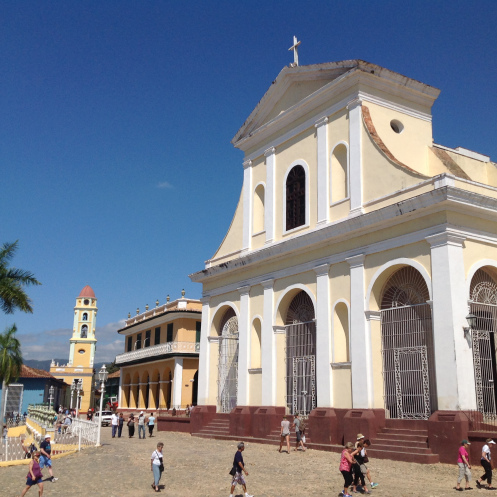
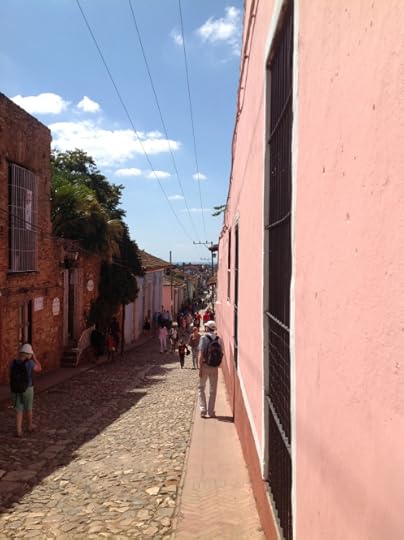
Mike stumbled upon an old fellow who surreptitiously sold some handmade cigars to him, cautioning, “Quick! Put them in your pocket!” The government owns all the legitimate cigar factories and 90% of the tobacco harvest. The 10% left to the farmers cannot be sold in the cities where “official” cigars are sold, so if you buy a cigar on the street, you most likely are taking part in an illegal activity. The government warns people not to buy “fakes.”
Interestingly, an illegal “fake” cigar is probably much better than an official Cohiba. In the sanctioned cigar factories, chemical additives adulterate the product. If you buy one from a tobacco farmer, you get an organic, hand rolled, unadulterated cigar, and for a whole lot less money. Mike thought he was just doing the guy a favor, but as it turned out, the so-called “fake” cigars he bought for our son-in-law are better than the official ones. They were much cheaper, too!
We had lunch at a nice place, but my stomach still was not cooperating. During the course of lunch, however, I made a surprising discovery: papaya contains a substance that settles the stomach. It is the go-to remedy for Cuban mothers when their children have a tummyache. I am not wild about them, especially since I had been subject to them at every meal since we hit the island, but when I ate some on this day and found my nausea lessening, I became quite a fan! I still did not eat much lunch, consisting of the usual heavy fare, but looked longingly at the avocados growing on the tree right above our heads. Why, oh why were we not served a single avocado on the entire trip? It was all I could do to keep from standing on the table, reaching up, and picking one of those huge, tasty-looking fruits right off the branch.
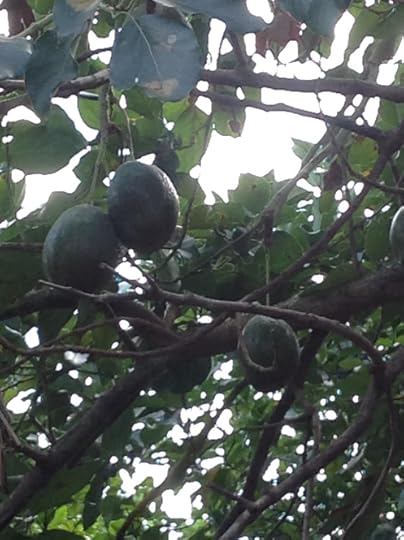
Leaving Trinidad, we went to El valle do los ingenios, the Valley of the Sugar Mills, stopping at an old plantation where we drank some delicious sugar cane juice (sans rum for me, thanks), and browsed along a street full of vendors. It was interesting, but I was saddened by what I saw and heard. The plantation had been farmed by slaves, and the evidence of their hardship was everywhere, from the poor descendants selling goods in the street to the picture of the slave mistress hanging on the wall in the front room, to the worn floor where slaves squeezed the juice from the cane by trudging around and around, pushing a heavy wooden pole. I grappled with the long pole, pushing it around to get a sense of what it felt like to have to work the cane. It was not easy.

The plantation tower. The view from the top is magnificient. Note the linens for sale

View from the top of the tower.
I decided not to post most of the pictures we took of the plantation. They were too depressing.
We had dinner back in Cienfuegos, which I did not enjoy due to the smokiness of the restaurant and the heavy food going into my sensitive tummy, but I found out some interesting information about the Santeria religion while we were there. When slaves were imported from Africa, they were deprived of their religious heritage. They ostensibly embraced Catholicism, but in reality used it to camouflage the continuation of their own by blending the two. One of the African dieties is Chango, the god of of fire, lightning, and thunder. He wears red and carries a knife or a hatchet. Saint Barbara also wears red, carries a knife, and is associated with lightening and fire. In the restaurant where we ate this evening, there were paintings of a, large, mucscular African man wearing a red loincloth, wielding a sword and a statue of pale Saint Barbara, holding her knife, wearing a read sash. She also had visited a pedicurist who had painted her toenails red. The two images standing side by side are a reflection of the hidden religion of Cuba.
Chango. Here he carries an ax. Below is Saint Barbara. Can you see the resemblance? They both carry sharp objects and wear red. They also both like lightening and thunder.
And because I found this and couldn’t resist:
Day 10, February 16, 2016
Our last day. We hurried out in the morning for one last walk around the block in this lovely town before we got back on the bus and headed to the airport at Santa Clara. The drive took us through the poorest areas we had seen on the trip—this was the first time we had seen shantytowns and ramshackle houses.

They aren’t in great shape, but they are painted in nice colors
Santa Clara is an interesting mix of old, colonial architecture and not so beautiful midcentury modern buildings like the ones in Havana that were built when Batista had decided to “modernize” the country. One of the biggest battles of the Revolution took place here. Che Guevara, one of the leaders of the Revolution did a dandy job of shooting the place up. Bullet holes adorn several of the buildings around the square.

See the bullet holes especially in the upper right. Che shot up the town pretty good
I got the feeling that Santa Clara was economically depressed, even though there were plenty of indicators of past wealth.

Sweet Gazebo built in the glory days
There were a few beggars, a rarity in Cuba, although they were not obnoxious. Richar the artist gave us a tour of the square, and we were intrigued by two women who stealthily followed us for the entire time. They never bothered us, but it felt a little odd, being so obviously followed. Unfortunately, I did not think to snap a picture of them. They haunt my memories.
After our tour, we went to lunch at an open-air restaurant, where we were served the usual heavy food. I had about three bites of shredded beef, which was not bad, just more than I wanted. For dessert, they served an excellent flan, along with the oddest thing: Milk balls. These were a concoction made of milk and sugar boiled down to a gooey consistency. It was about as tasty as it sounds.
And then, it was time to go. We were dropped off at the airport, which was nicer and much newer than the Havana airport. They actually had a snack bar and comfortable places to sit, and Hallelujah! The bathrooms were clean, the toilets flushed, and there was plenty of running water in the sinks! Our last visit to the loo in Cuba was far superior to our first (and all the ones in between). We all had a nice time visiting with each other one last time before we boarded our plane and headed for Miami and home.
It was a great trip, an adventure that we are very glad we took. We may have been coddled more than the average tourist, and for that I am grateful. The fact that Roberto, Elizabeth, Leyte, and Saul worked so hard to keep us comfortable and fed with the very best Cuba had to offer did not diminish the authenticity of the experience. I still got to drive a rattling Russian car through the back country, ride a sweet ox, drink sugar care juice at the source, toy with the idea of smoking a hand rolled cigar, swim in a crystal pool and many other, delightful adventures.
I came away feeling both better and worse about the country, the people, the Socialist government, the Revolution. There is no doubt that Cuba is a hard country, and the plight of the people is not good. But it has always been a hard country for the people who live there. Before the Revolution, there was slavery, then near-slavery under the heavy thumb of foreign ownership and a dictator who cared little for his people. After the Revolution—well, people are living under an equally ruthless dictatorship, and while they are poor and oppressed, I believe that the average citizen is better off now. They may not have internet or shopping malls or. . . oh, yes. . . that little thing called freedom. They may live in starving conditions at times, but they do have free medical care and educational opportunities, and they are finding ways to make their lives better. Resourceful, kind, and hopeful, the Cuban people were inspirational to me. I am glad I have the privilege to know a few: Roberto and Leyte, now both American citizens, and Alicia and Felix, along with all the other generous souls we came across: our hosts at the B & B in Cienfuegos, the hardworking farmers, the students and young people who look forward to a brighter future, the artists and artisans who toil long hours to make a better life. Although Mike and I have visited some of the old Soviet bloc nations that are still struggling with the legacy of Communist oppression, Cuba was our first “practicing” Socialist country. We came back richer for the experience, with an appreciation for differences of political opinions, and for the fact that we live in a free society. I am grateful for the opportunity to travel, and the opportunity to come home to a safe, comfortable, beautiful environment, and I am grateful for friendship that transcends political boundaries. God bless Cuba. May she and her people live long, live up to their potential, and someday, live free.

1963

2016, With our hosts, Felix and Alicia the joyful


March 3, 2016
Feasting in Cuba, Days 6 and 7
Day 6: No Traveling Mercies
Mike and I awoke early after a nice, sound sleep and strolled down to breakfast. No one in our group had showed up, so we lingered over it (oh, the joys of a good cup of tea!) for a while, but no one came along. We dawdled until we realized time was getting short before we had to board the bus for our departure. This would be the day we left Havana. We were eager to see what was next.
We packed up, got our luggage into the lobby, and waited. No one came. Time ticked by, and we were beginning to wonder, when we finally saw a few of our group straggling in. My attempt to give someone a morning hug was waved off. The problem? Nearly everyone had spent a miserable night suffering from the effects of either bad water or whatever they had enjoyed so much at dinner. Mike and I had escaped it, even though we had eaten the same things everyone else had. We couldn’t help but brag that we have exceptionally robust immune systems because we live on a farm and are a bit cavalier about hygienic. We have given our bodies the tools to combat all manner of horrible pathogens. Rick and Ruth, who had spent the day recovering from Ruth’s fall and had missed dinner also were spared, along with one other person whose hygiene I do not question. Even our bus driver was barely able to hold his head up.
I felt terrible for our poor group leaders! They were suffering on several levels. Not only were they sick, but they also were having to deal with the suffering of others. Fortunately, there was a doctor on call right there in the hotel. All the desperately ill were treated without charge, and the doctor assured us that the gift bestowed by Guarijito’s (aka “Hooter’s”) would be reported to the proper authorities. I couldn’t help but feel a little sorry for the poor waitresses. It could be a long time before they got the chance to serve generously-tipping Americans. But then, perhaps not. Judging from the lax standards of the tourism bureau, maybe restaurants spreading food poisoning are not treated too severly.
There was no question of waiting around until everyone had recovered before leaving the hotel. The Hotel Nacional is the premier hotel in Havana, and much in demand. Leyte, our travel agent,hotel had moved heaven and earth to get us as many days there as we had, and no matter how bad everyone felt, we had to leave. Onto the bus we filed. Our usual chatty, laughing crew remained quiet for the whole trip, most of them curled into the fetal position. It was a long bus ride to our next destination, Varadero Beach resort, about 100 miles away.
On our way, we passed through Santa Cruz, a town that seemed to be built in the old Soviet style block buildings. It was surprising to see, and very out of place after all the grandly beautiful buildings of Havana and the neat, joyfully painted houses we had seen previously.
After a few stops to see some beautiful views, we finally pulled in to the hotel, an all-inclusive Caribbean beach resort, with an open-air lobby, and acres of luxurious pools, spas, restaurants, pavilions for bands and entertainment, and play areas. I had not dreamed that such a resort could belong in this third world country! Four open bars with accommodating bartenders stood in each corner of the lobby. In the event you felt the bartenders were not heavy handed enough with the rum, there was a table by the reception desk loaded with all kinds of booze and mixers where you could serve yourself. All I could think of was, “Oh, Lord! Don’t let Spring Break bound college students find out about this one!” The open bar at the airport was just a little refreshment stand by comparison. This was an open invitation to kill two thirds of your brain cells.

Our Resort was far more than I expected

The beach I didn’t have time to enjoy
It was past lunchtime, so I strolled over to the all-inclusive restaurant, where, lo and behold, I found PIZZA! Ha! Paradise! It turned out to be one of the blandest pizzas I had ever tasted, but it was such a welcome departure from grilled meat and black beans and rice that I pretty much cleaned out the buffet. After we unpacked, I explored the property, but Mike was beginning to feel a little off. By dinnertime, he had repented of his bragging that our farm living had protected us from Castro’s revenge, and I skipped off to dinner alone.
Dinner was a sad affair. A few people managed to drag themselves to the party that fizzled. The food was not great, but I chalked that up to the fact that the place obviously catered to Canadian tastes (Canadian flags hung from the rafters), which are somewhat different from American tastes, and very different from Southerners’. We were supposed to have gone down to the beach for music and karaoke after dinner, but I don’t think anybody made it. I went back to the room to read and feel sorry for Mike who occupied the bathroom the whole night.
Day 7: Roads, trails, and rivers.
This was the day of our jeep tour. Mike and several of the others in our group were still feeling bad, so a small number of us boarded the van to go to our departure point. I was not sure what to expect, but I certainly was surprised when our guide informed us that the cars would be driven by anyone in the group with a passing familiarity with a stick shift. Never mind that I did not have my driver’s license with me; the fact that I could handle a clutch made me designated driver to three other trusting souls. With a sense of adventure and pride, I called for a posse, and was not surprised when three of the four Las Moras (the fourth was back at the resort, still dealing with her bad stomach) jumped right up to volunteer. Off we went across the back roads of Cuba, feeling like Thelma and Louise x 3—the car with the hottest chicks.
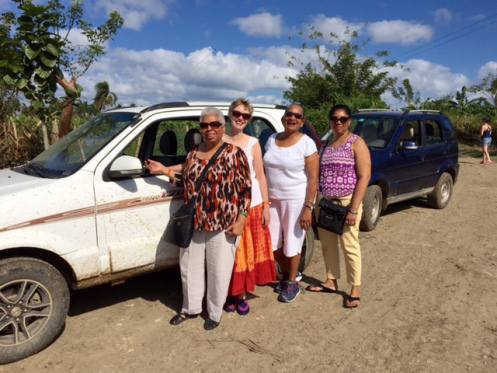
What an adventure! The roads were terrible: rutted, rough, and muddy. I soon had to make a difficult decision: Do I run straight over the 12 inch deep ruts and holes (resulting in the shortening of everyone’s spine), or do I try to avoid the holes and ruts by swinging wildly from one side to the other? (this might not be welcomed by the ladies in the back seat who were still recovering from upset stomach) After a brief consult, everyone decided that swinging wildly from side to side was preferable to shortening our spines and rattling our teeth out.
We drove into the rough countryside, by farms that were not as prosperous- looking as the ones we had seen on the earlier part of our trip. However, they all had the same enviable dirt, and the people seemed poor, but clean and proud. Children ran out to see us pass by. A few held out bunches of flowers they were hoping we would buy, but there was no time to stop or even slow down. It had not crossed our leader’s mind that the road needed to be negotiated carefully. Every time I slowed for a series of deep ruts, I was left in the dust, and I had to floor it to get back up to the line. By the time we made it to our first destination, we had driven through a few muddy rivers, across chasms, over fields of stubble, our car was missing a few nuts and bolts, and it looked as if it had been wallowing in a pig sty. We hot chicks who were still up for anything were hoarse from shrieking.
Our first stop was at a small farm in the middle of nowhere. Like every other farm we had seen, it was marvelously tidy, although the homestead did not look nearly as nice.
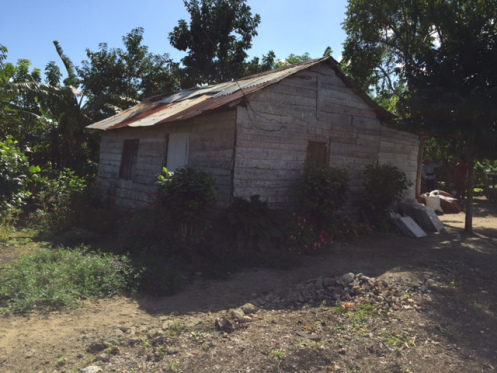
The farmer had left his turning fork stuck in one of the rows, and, lured by that beautiful, black dirt, I gave it a try.
Dear friends, that soil is heavy, dark, and impossible for an old lady to turn. I came away with a deep respect for the farmers in Cuba, who do every bit of the work by hand, by ox, and by horse. The whole time we were on the island, I saw exactly two plowing machines. I don’t know what happened to all the heavy equipment used at the big plantations before the Revolution, but I am sure they are missed by the average yeoman farmer today.

Roberto turning the soil I couldn’t lift. Note the handle to the turning fork made from a crooked tree branch. Also notice that beautiful dirt.
Leaving the central farming areas, we made our way to a cave containing a deep-water pool of clear fresh, sparkling water. After half a century of swimming in Tennessee and North Carolina rivers and creeks, which are cold enough to set jello (not an overstatement), I have, in my old age, declared that I no longer do cold water. I say this so you will know how extremely brave and adventuresome of me it was to actually get in said pool. I’m glad I did. The water was not nearly as cold as I expected it to be, but refreshing and invigorating. The only hard part about the experience was trying to get dressed again after the swim. Shucking a wet swimsuit behind the bushes under the cover of a skirt pulled up around my neck is harder than I remembered it to be.
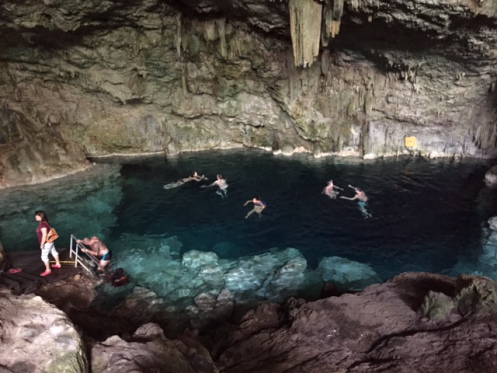
The adventure continued. We next made our way to an odd touristy kind of marina where some native Cubans, dressed in loincloths and a bit of body paint danced for us. I didn’t understand the context, and observed the ceremonious dance in a very perplexed state.
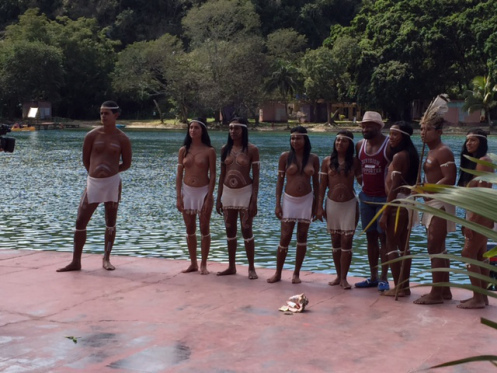
From there, we took a boat trip. By then, we were seasoned road warriors, and were not in the least fazed when it was revealed that we also were responsible for driving the boats. I relinquished my Thelma position to Vedia, who admitted to a familiarity with motorboats and took the helm. I got in the right boat. Wendell, the young Cuban who had been our guide for most of the week, had never even been in a boat before, but that did not stop him from boldly stepping into the Captain’s chair. During the trip upriver, the extent of his inexperience became very evident, but he never stopped smiling, even when he nearly rammed another boat.

Captain Vedia
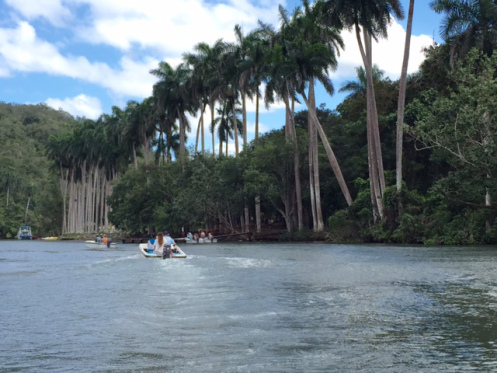
We made it to our lunch destination with only a few tiny mishaps to a riverside open-air restaurant where we had our usual choice of fresh fish and seafood, roasted pork or chicken, and—you guessed it, all the black beans and rice you wanted. Not to sound like a broken record, I had pork, black beans and rice, papaya, pineapple, and cabbage. I wanted to tell my cohorts to shut up about how good the fish was. Apparently, there are many different types of fish in the seas and the rivers, and they all taste different, unlike the different types of chicken and pork.
But the live music and the lovely spot down by the river which invited a restful moment and a nice conversation with a Chinese woman who had settled in Toronto made the lunch a happy experience indeed.
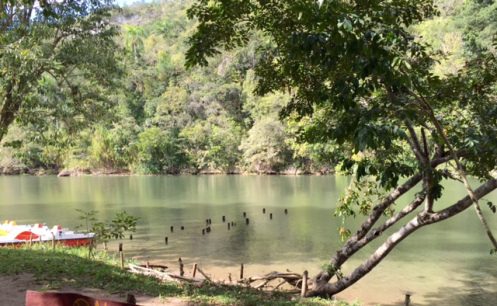
I got behind the wheel again for the trip home, and was more than a little glad that my driving did not cause anyone in the back seat to lose her lunch. I, however, was beginning to realize that I was going to lose mine before the night was over. Mike and I switched places. I spent the evening and night throwing up in the bathroom while he went out to enjoy a good slab of beef at the dining room.


March 1, 2016
Feasting in Cuba, Day 5
By now, word is out that we are on a culinary tour, and every tourist in town wants to know about it. With a slightly desperate look in their eyes, strangers track us down, grab us by the co…
Source: Feasting in Cuba, Day 5


Feasting in Cuba, Day 5
By now, word is out that we are on a culinary tour, and every tourist in town wants to know about it. With a slightly desperate look in their eyes, strangers track us down, grab us by the collar and say, “Are you on the culinary tour? How do we get on that one?”
This is an indication of what I have been suspecting for some time now: By almost any standards, authentic, non-Anglicized Cuban food is nothing to crow about. Those of us on the culinary tour have been treated to the very best. We are led by a Cuban chef and a Cuban travel agent whose primary purpose is to find us the best restaurants. And while the food is extremely fresh, from well-run, organic farms, and has been very well prepared, it also has been predictable. I have had a more mediocre time of it than anyone else, being allergic to fish and seafood, so until now, all my entrees have been poultry and pork, and it always has been prepared in basically the same way: grilled, with very little seasoning. All of us have been served black beans and rice at Every. Single. Meal. Shredded cabbage, papaya, pineapple and yucca have been at nearly every table, with a rare cameo appearance of tomatoes and sweet potatoes. I can understand why people are mobbing us in the elevators and the lobby to find out where to get something good to eat.
Our guides have also worked very hard to keep us safe. They vet every restaurant to make sure they make their ice and wash the vegetables with filtered water. There is a reason for this. Look around you and see how many people are green around the gills. My guess is some have been cavalier about the “Don’t drink the water” rule.
We are getting out of Havana for the day to go see Viñales Valley, Cuba’s version of Yosemite. It is a grand valley ringed by the Sierra de los Organos, much different from our beloved mountains back in North Carolina and Tennessee. These mountains are craggier, less undulating, pockmarked with thousands of caves. I can imagine they provided excellent hiding places for privateers roaming the Caribbean in the 15th and 16th centuries, and can’t help but wonder if there is any booty still resting up there somewhere. This is not the place where Castro and his merry band hid out during the long years of the Revolution (that was in the Sierra Maestra at the southeastern end of the island), but if those mountains are as riddled with caves as the Sierra de los Organos are, I can understand why the Revolutionaries managed to elude Batista’s army for so many years, from 1953 to 1959.

Vinales Valley. If you look close, you can see caves up in the hills.
Two members of our group were not with us today. I have mentioned that the streets and sidewalks of Havana are full of potholes and construction holes. Our friends Ruth and Rick had gone out for a walk last night, and Ruth fell into one of them, banging up her face and chest, and badly wrenching her arm (it was a deep hole!). This gave her the chance to experience not only the health care system of Cuba, but also the kindness of the Cuban people. The minute she fell, everyone nearby rushed to her aid, helping her up, summoning a taxi, and getting her to a clinic. She proclaims the medical care excellent. While it would have been free if she had been a Cuban, she was charged $200 to get checked out and patched up. So now you know that if you fall and hurt yourself while in Cuba, you will be well taken care of. Just bring some cash.
Riding through the Cuban mountains and valleys, I was struck that the farms and the houses were small, but tidy and colorful. We did not see any dilapidated trailer parks or the kind of ragged “hillbilly” houses you so often encounter in the poorer communities of Appalachia. Before the Revolution, huge plantations, mostly owned by foreigners and worked by landless peasants, grew all the produce. After the Revolution, Castro nationalized the plantations and divided them up, giving the people who had worked the land up to 100 acres each to call their own.
I was impressed by what this seemed to accomplish. Everywhere we looked, we saw beautiful little farms, perfectly tended. It seemed to be a good model: smallish farms, with the owners working for themselves and maintaining their homes and land with the pride of ownership.
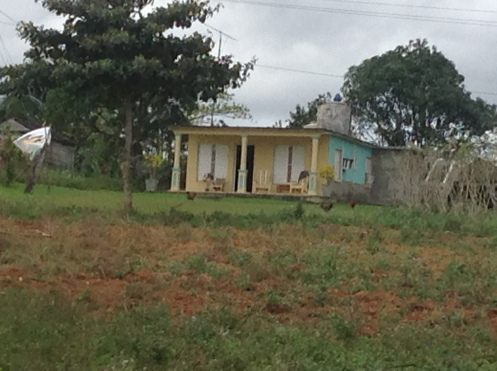
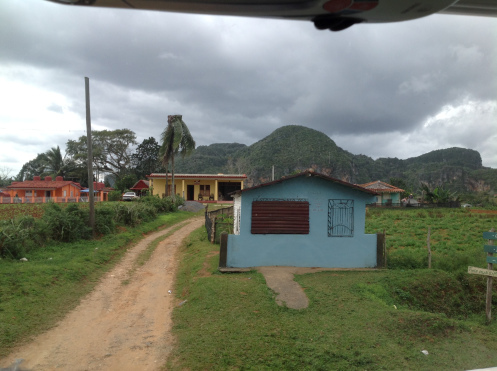
Of course, there is a dark side to this idyllic situation: People who backed the wrong side of the Revolution were lucky if all that happened to them was losing their land and their homes. If they had been too sympathetic to the Batista government, they lost their necks as well. Of those awarded land, not everybody got 100 acres. The number and quality of acerage parceled out depending upon one’s status within the Revolution hierarchy. The farmers who did receive a good farm have never had complete control over it. They are beholden to the government to provide a certain amount of produce, and they do not actually own everything they grow. The oddest thing I discovered is that the government owns every single cow in the nation, and Cubans are not allowed to eat ANY beef! It is reserved strictly for tourists. As our local guide, Wendell says, “Cows are as sacred in Cuba as they are in India, but for different reasons.” I wonder how they are going to keep Cubans from driving through MacDonald’s when the embargo is lifted and American companies are welcomed back into the island.
At lunchtime, we stopped at a place dominated by a giant mural painted on the side of the mountain. I’ll just post pictures here and you can get the idea.

The big mural. See all the caves?
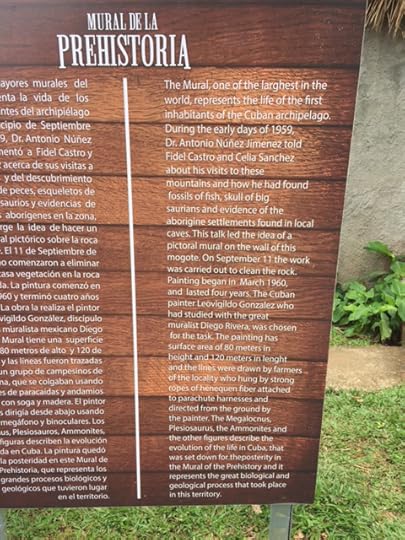

The mural up close. I don’t know why they took the time to paint all of it in stripes rather than in large swathes. Every inch of it looks like this.
I also picked up another Cuban boyfriend here (sorry Gualberto, for being so fickle) who offered me a ride on his sweet ox. I’ve never seen a cleaner beast, or one better cared for. It was a pleasure to ride him.

Me with my new boyfriend. I was having too good a time riding the ox to notice that he has his hand on my knee
Lunch was roasted pork. As always, it was perfectly prepared and accompanied by shredded cabbage, papaya, and pineapple, but I am really missing spices, variety, and some good old Southern style vegetables. I was very happy to see tomatoes, which I gobbled down and then licked the plate. The tomatoes are delicious here, but I do not know why they are stingy with them when they are grown on every farm we saw. They certainly are not at all stingy with the pork, chicken, fish, papaya, pineapple, or yucca.

Beautiful open air restaurant and pavilions. Lunch was pork roasted that day on the premisis
We had planned to visit some caves (“Indian Caves”) and take a boat trip along a river, but even though we had already bought and paid for reservations, when we got there, we were informed that too many people were visiting that day and we would have to wait several hours before we could take our turn. Of course, we did not have time for that, so we lost the opportunity. Another example of the bureau of tourism selling tickets that they knew they would not honor, and they were not inclined to refund our money. Their attitude is that it was not their fault that we refused to wait around.
We were not particularly disgruntled by this. Everyone in our group has a spirit of adventure, and we easily shrugged off these little setbacks. However, I mention it because incidents like this point out the fact that Cuba is not ready for mass tourism. Early in my first blog post, I had said that Mike and I had wanted to go to Cuba “before it got ruined,” but I was thinking in terms of a future of MacDonalds and KFCs on every corner. In reality, the ruining will be, not from American fast food joints taking over, but from the collapse of an infrastructure that will not be able to handle thousands of Americans descending on this small island. Already it is becoming a big problem. In November 2015, four tour busses per week came to Indian Caves. Now, just 3 months later, there are 10 per day! No effort has been made to curtail the number of visitors at this tiny, out of the way natural wonder. Busses were parked EVERYWHERE, tearing up the grass and the shoulders of the roads, blocking traffic, and making walking a hazard. This is an indication of what is happening all over Cuba. Last summer, a cruise ship showed up into port only about once or twice a week. According to the preservation architect who showed us around Havana on our second day, the expectation is that 10 cruise ships per day will be coming into Havana alone during the next year. Currently, only about 15 charter flights from America come to Cuba daily. Under the new agreement with the United States, commercial airlines will be increasing the numbers to over 100 per day. Do you think that might pose a teensy tinesy problem for an island whose bureau of tourism is run by people who really don’t care if everyone finds a place to sleep?
We arrived back to Havana late because the bus got a flat tire and we had to limp back slowly (there were 4 tires per axle, so most of us moved to one side of the bus to redistribute the weight, and we made it. Our driver was resourceful). By then we were starving. Since the place we were supposed to have eaten dinner had cancelled on us, our guides did their best to find a place and vet it for cleanliness and reputation. Guarijito’s was fun, sort of like a Cuban version of Hooter’s. The waitresses were clearly hired on the merits of their looks and not on their cognitive skills. The food, however, was good, and most everyone really enjoyed it, especially my friend Wally who raved about his shrimp. I had beef for the first time. It was shredded and covered with a type of barbeque sauce. I have since learned that the only way you can have beef in Cuba is to: a) not be Cuban and b) eat it shredded.
After that, we were happy to pile back into the bus and make our way back to the hotel. It had been a long, but interesting and beautiful day.


Deborah Hining's Blog
- Deborah Hining's profile
- 26 followers



